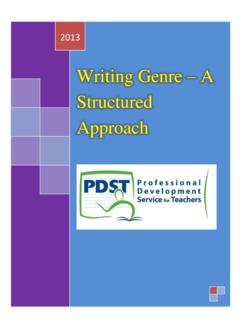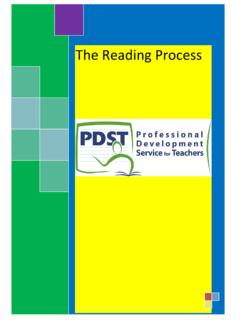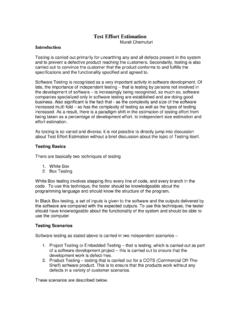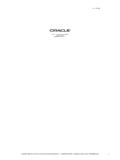Transcription of Mental Maths Strategies for Multiplication and Division
1 Practical Approaches to Developing Mental Maths Strategies for Multiplication and Division This manual has been designed by members of the Professional Development Service for Teachers. Its sole purpose is to enhance teaching and learning in Irish primary schools and it will be mediated to practising teachers in the professional development setting. Thereafter it will be available as a free downloadable resource on for use in the classroom. This resource is strictly the intellectual property of PDST and it is not intended that it be made commercially available through publishers.
2 All ideas, suggestions and activities remain the intellectual property of PDST (all ideas and activities that were sourced elsewhere and are not those of the authors are acknowledged throughout the manual). It is not permitted to use this manual for any purpose other than as a resource to enhance teaching and learning. Any queries related to its usage should be sent in writing to: Professional Development Service for Teachers, 14, Joyce Way, Park West Business Park, Nangor Road, Dublin 12. 1 Contents Introduction .. 4 Background Knowledge for Teachers.
3 5 Stages of Progression .. 5 Multiplication Symbol .. 5 Known Facts .. 6 Teaching Multiplication and Division .. 6 Dealing with Remainders .. 6 Division using Arrays .. 7 Linear, Area and Set Model for Multiplication and Division .. 8 Possible Pupil Misconceptions .. 9 Uses of Mental Calculation .. 11 Fundamental Facts for Multiplication and Division .. 12 The Commutative Property .. 12 The Associative Property .. 12 The Distributive Property .. 12 Inverse Relationship .. 12 Teaching and Learning .. 13 Suggested Multiplication & Division Strategies .
4 13 Instructional Framework .. 14 Classroom Culture .. 16 Problems and Solutions in Supporting and Developing Mathematical Thinking .. 17 Possible Resources .. 18 Key Teaching Principles for Mental Maths .. 18 Assessment .. 19 Teacher Manuals for Supporting and Developing Mathematical Thinking .. 20 Practical Strategies to Develop Multiplication and Division Properties .. 21 Commutative Property .. 21 Distributive property of Multiplication .. 22 2 Practical Activities for developing Multiplication & Division Strategies .. 24 Skip counting .. 24 Skip Counting for Division .
5 25 Multiplication Strategy: Repeated Addition .. 25 Repeated Subtraction for Division .. 27 Division as inverse Multiplication with Cuisenaire Rods .. 30 Division as inverse Multiplication - Area .. 31 Multiplication & Division Fact Families .. 32 Multiplication Strategy: Doubles .. 33 Double and one more set .. 33 Double and Double Again .. 34 Multiplication Strategy: Known Facts .. 35 Multiples of 10 (links to facts for doubles, known facts and counting stick activities) .. 35 Rounding and Compensating Strategy .. 35 Making Friendly Numbers Strategy.
6 37 Partitioning Strategies .. 38 Partial Products .. 39 Division Strategy: Partial Quotients .. 42 Doubling/Halving .. 43 Pose the following problem to the children: .. 47 Proportional Reasoning/Adjustment for Division .. 48 Breaking Factors into Smaller Factors and 49 Think Multiplication for Division .. 51 Towards Fluency and Consolidation in Applying Strategies .. 53 Counting Activities using Multiplication and 58 Possible Sequence for Developing Multiplication Facts .. 61 Further Examples for Exploring and Embedding Strategies .. 64 References.
7 67 3 4 Introduction This booklet is intended to support teachers in developing Multiplication and Division Mental Maths Strategies in their classrooms. It has been designed to accompany the PDST Mental Maths workshops. The booklet explores the key properties of number and number relationships relating to Multiplication and Division and outlines practical approaches to developing an understanding of these. It also explores background knowledge for teachers and fundamental facts in relation to Mental Maths . A range of concrete, practical activities that will support pupils in their development of Multiplication and Division Mental Maths Strategies are also outlined.
8 Also included is a suggested alternative strategic sequence through which pupils may acquire their Multiplication facts. Finally, a selection of engaging and enjoyable activities to consolidate learning and provide opportunities for pupils to master Multiplication and Division facts is included. 5 Background Knowledge for Teachers Stages of Progression Arthur Baroody 1 identifies three stages through which children progress in order to acquire the basic facts of addition, subtraction, Multiplication and Division : 1. Counting Strategies : using object counting (for example blocks or fingers) or verbal counting to determine the answer.
9 For example, with 3 7 pupil starts with 7 and skip counts on verbally 7, 14, 21. 2. Reasoning Strategies : using known information to logically determine an unknown combination. For example, with 3 7 pupil knows that double 7 is 14 and one more set of 7 is 21. 3. Mastery: efficient (fast and accurate) production of answers. For example, with 3 7, pupil quickly responds, It s 21; I just know it. Multiplication Symbol 2 The use of the Multiplication sign can cause difficulties. Strictly, 3 4 means four threes or 3 + 3 + 3 + 3.
10 Read correctly, it means 3 multiplied by 4. However, colloquially it is read as 3 times 4 , which is 4 + 4 + 4 or three fours. Fortunately, Multiplication is commutative: 3 4 is equal to 4 3, so the outcome is the same. It is also a good idea to encourage children to think of any product either way round, as 3 4 or as 4 3, as this reduces the facts that they need to remember by half. 1 Baroody, A (2006) Why Children Have Difficulties Mastering the Basic Number Combinations and how to help them 2 Crown (2010) Teaching Children to Calculate Mentally Three different ways of thinking about Multiplication are: As repeated addition, for example 3 + 3 + 3 + 3 As an array, for example four rows of three objects As a scaling factor, for example, making a line 3 cm long four times (Crown.)

















